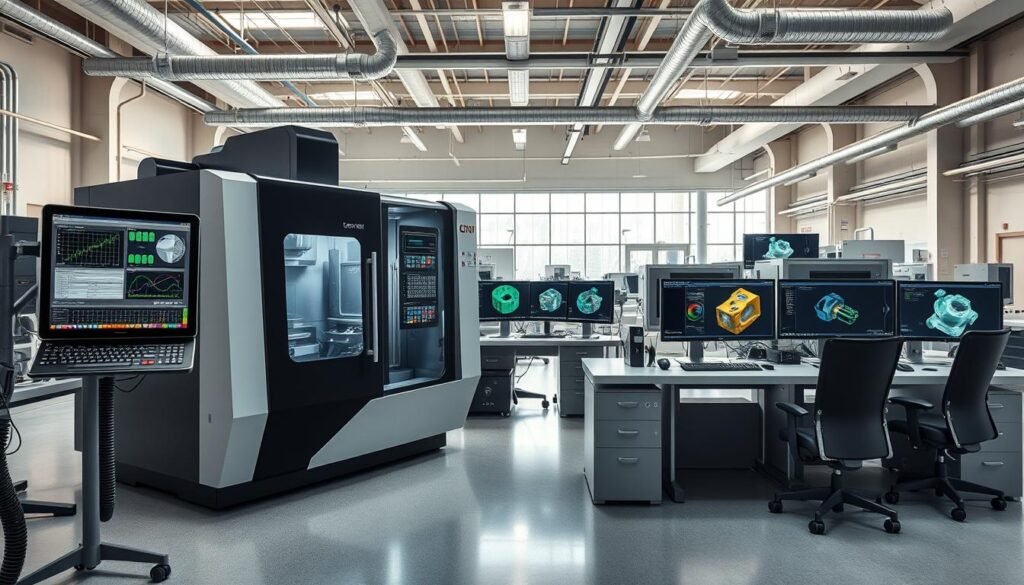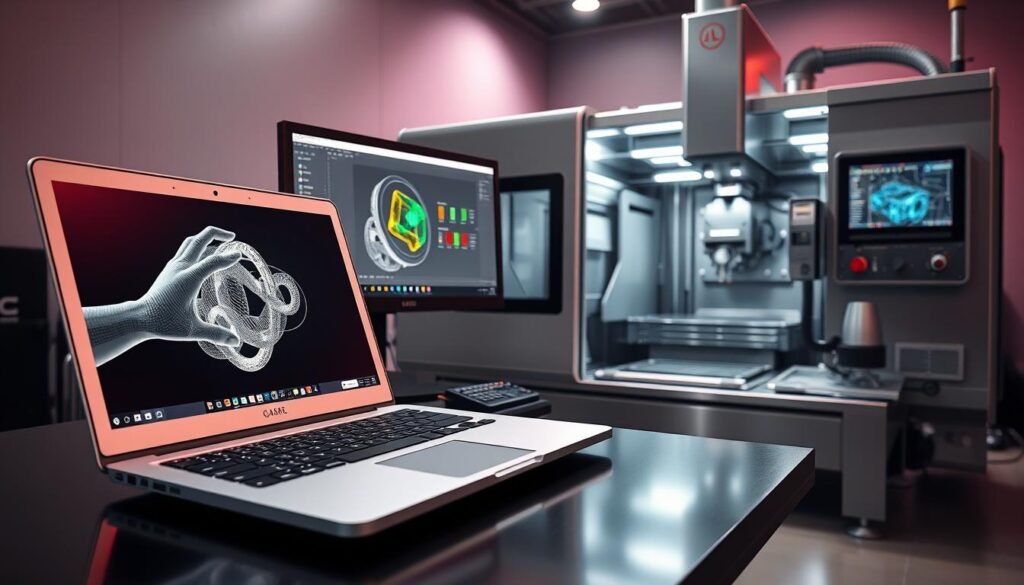We are in a time of great change in advanced manufacturing technology. Being good at CNC machining makes companies stand out. It also moves the industry forward. At the center of making things with precision is knowing CNC programming well. This is key, even as more tasks are automated. CNC programming isn’t just about using machine tools. It’s about creating a perfect flow of movements and designs. This can only be done by someone who really knows how.
In the United States, being precise and efficient is very important. But there’s a big problem: by 2030, about 2.1 million manufacturing jobs might not have anyone to do them. This forecast comes from a study by Deloitte and The Manufacturing Institute. So, getting better at CNC programming isn’t just good; it’s critical. It helps keep American manufacturing at the top. With this in mind, we’ve put together some key CNC programming tips. They’ll improve your skills and make you crucial in this field of high precision.
Key Takeaways
- Understanding the critical role of CNC programming expertise in upholding advanced manufacturing technology standards.
- Equipping oneself with strategies to enhance CNC machining efficiency amidst a widening skills gap.
- Incorporating precision engineering techniques to upgrade the quality and intricacy of machined components.
- Identifying the essential tools and software that drive effective and precise CNC programming practices.
- Staying ahead of industry challenges by adhering to best practices and continual learning in CNC programming.
Understanding the Basics of CNC Programming
CNC programming is key in modern making of things. It uses detailed instructions to control machine tools. These rules change how we shape raw materials. They make manufacturing faster, more accurate, and consistent.
What Is CNC Programming?
CNC programming is about creating instructions for machines to do complex jobs. It covers actions from simple cuts to complex moves. This makes precise parts possible. It’s vital for industries that change raw materials, helping them do more with machines.
The Role of G-Codes and M-Codes in Programming
G-Codes and M-Codes are crucial in CNC programming. G-Codes guide the machine’s movements. M-Codes control its functions, like starting or stopping the spindle. Knowing these codes is essential. They are the language of CNC machines.
The Different Types of CNC Programming
CNC programming comes in many forms. Manual programming involves writing each code by hand. Computer-aided manufacturing uses software to help. Each method has its benefits. They aim to make making things more efficient, ensuring high quality while saving time and resources.
Strategies to Enhance CNC Programming Efficiency
To boost CNC programming efficiency, understanding the importance of advanced software and improving processes is key. By improving how we program and using top CAM software, we make manufacturing faster and more precise.
Optimizing Your Programming Approach
Automated workholding and unattended operation systems are core to better CNC programming. These tech solutions make machining smoother and increase productivity by allowing machines to run without constant supervision. They reduce mistakes made by people and maximize how much we can produce.
Leveraging CAM Software for Enhanced Outcomes
Advanced CAM software is critical for getting the most from CNC machines. It simplifies creating complex toolpaths and boosts programming efficiency. It does this by auto-adjusting cutting conditions, which helps tools last longer and cuts down on waste.
Furthermore, CAM software has machine monitoring systems. These systems offer insights into how machines are performing and when they might need fixing. This helps keep operations running smoothly and efficiently.

To excel in CNC programming, applying these strategies is essential. They improve manufacturing efficiency and the quality of what we make. Embracing these tech advancements helps businesses keep up in the fast-paced manufacturing world.
How to Program CNC with Confidence
Learning to program CNC machines starts with the basics. Begin with simple projects to gain confidence and a solid base. This sets you up for tackling tougher tasks later. CNC programming training is essential, as is practicing regularly. It helps you grow your skills step by step.
Starting with simple projects is great for beginners. It lets you get the feel of CNC machining by learning coding, setup, and operation basics. This way, you won’t get too overwhelmed. As you get better, you can move on to more challenging projects. These not only teach you more about CNC programming but also improve your problem-solving skills.
| Phase | Focus Area | Benefits |
|---|---|---|
| Initial | Simple Projects | Foundational skills, Basic problem-solving |
| Intermediate | Skill Enhancement | Increased confidence, Advanced techniques |
| Advanced | Complex Projects | Expertise in programming, Precision machining |
To get better at CNC programming, you need to keep practicing. Improving your tool path strategies is key to being efficient and precise. This is crucial for mastering CNC programming.
A structured CNC programming training course can make a big difference. It starts with the basics and then introduces more complex tasks. As you become more skilled, you’ll be able to do advanced machining projects. This leads to strong skill development.
Key CNC Programming Tools and Software Solutions
As we step into the future of manufacturing, having the best tools is key. They boost CNC programming greatly. The blend of CAD/CAM integration merges design and making things in a digital world. This makes it easier to go from ideas to making things real, placing us at the industry’s forefront.
Picking the right CAD/CAM tools is crucial. It’s not just about new software, but about a system that makes programming easier and simplifies making things. These tools link engineers’ ideas with real results.  technology also mirrors the real manufacturing world. It lets us analyze and simulate in real-time.
technology also mirrors the real manufacturing world. It lets us analyze and simulate in real-time.
Advanced simulation is key for foreseeing how a system acts under stress, cutting down on errors. This simulation helps refine CNC programs for better precision. This happens before we even start cutting materials.
Choosing the Right CAD/CAM Tools
There are many CAD/CAM tools out there, but certain features are important. Look for software with a big library, easy-to-use interfaces, and strong simulation that gives real feedback. A good set of tools makes work flow better and cuts down on setting up programs. This is very important in quick production settings.
Integrating Advanced Simulation Technologies
Advanced simulation in CNC programming is more than checking designs. It includes stress tests, studying how things react to heat, and virtual machining trials. These steps are important for seeing how machining paths will turn out. Making necessary changes to optimize manufacturing, this cuts down on waste and time.
Common CNC Programming Challenges and How to Overcome Them
The world of CNC programming is changing fast. This brings both opportunities and challenges for manufacturers. One big problem is the lack of skilled workers. This makes it hard to keep up and innovate. To tackle these issues, it’s crucial to use advanced strategies like planning ahead to avoid mistakes and becoming skilled with CAM software.
Making fewer errors is key in CNC programming. Planning carefully and executing with precision helps avoid downtime and expensive errors. By mastering CAM software, programmers can get better at their jobs. This makes operations run smoother and more efficiently.
To deal with the shortage of skilled CNC machinists, leaders in the industry need to focus on training. Investing in education and training helps grow a skilled workforce. This is important to keep up with new technologies. Training in the latest CAM tech helps close the skills gap. It also pushes a company’s operations to do better, meeting today’s manufacturing needs.
Taking smart steps can help manufacturers deal with the challenges of CNC programming. This helps them stay ahead in a field that’s always changing. It gives them an advantage in a technical and competitive area.
Advanced Tips to Program CNC Like a Pro
To become a pro in CNC programming, you need to learn some advanced skills. Skills like high-efficiency milling and adaptive clearing are key. They improve your work quality and make manufacturing smoother.
High-efficiency milling (HEM) uses high feed rates and deep cuts to boost material removal rates. This method is great because it generates less heat and wears down tools slower. Keeping your equipment in good shape for longer. It’s vital for efficient CNC programs.
Adaptive clearing is another cool technique. It changes the cutting path in real-time to cut materials evenly. This keeps the chip load steady and lowers the chance of tools breaking. It’s super useful for tough materials. Experienced CNC programmers who want precise and efficient cuts often use it.
Let’s compare how these techniques help with productivity:
| Technique | Material Removal Rate | Tool Wear Reduction | Heat Generation |
|---|---|---|---|
| High-Efficiency Milling | High | Significant | Low |
| Adaptive Clearing | Optimized | Considerable | Managed |
Using these advanced CNC programming methods boosts your results and efficiency. High-efficiency milling and adaptive clearing are key for better material removal and CNC programming.
Conclusion
In the fast-changing world of manufacturing, mastering CNC programming is key. It sets the skilled apart from the rest. This deep dive into CNC programming offers valuable insights. It helps industry professionals confidently tackle complicated programming tasks. We’ve talked about the important roles of G-codes and M-codes. The benefits of CAM software and the positive effects of new manufacturing technologies were covered too.
As sector leaders, our goal is to push machinery to its limits using sophisticated CAD/CAM tools. These tools and simulations support the creators of future manufacturing wonders. The mix of smart innovations by machinists and the latest technology shows our commitment. It shows our drive to offer top manufacturing solutions. Making the most of this mix is crucial. It’s the blend of human creativity and machine accuracy that leads to breakthroughs in making precise products.
To wrap up, continuous learning and improving CNC programming skills are crucial. We, as its guardians, need to keep improving our practices and tools. This keeps us ahead in innovation. It creates a strong and impressive manufacturing environment. The work we do now with our technical skills will be admired for years. It will be seen as a symbol of progress and strong commitment to manufacturing excellence.
FAQ
What Is CNC Programming?
CNC programming is creating detailed instructions for a CNC machine. These instructions control the machine’s movements to make parts from raw material. It turns a raw piece into a precise finished product through coding.
What is the role of G-Codes and M-Codes in CNC Programming?
G-Codes and M-Codes are key in CNC programming. G-Codes manage the machine’s motion. M-Codes handle functions like starting or stopping the spindle and coolant. They direct the CNC machine’s actions.
What are the different types of CNC Programming?
There are several types of CNC programming. Manual programming involves writing commands by hand. Conversational programming uses an easier interface. CAM programming uses software to create code from 3D models.
How can I optimize my CNC programming approach?
To optimize CNC programming, know the machine’s capabilities well. Pick the right cutting tools and plan your toolpaths carefully. Use simulation software to check programs. Apply the best setup and documentation practices to boost efficiency.
How does leveraging CAM software enhance CNC programming outcomes?
CAM software improves CNC programming by making code generation faster. It enhances precision with advanced algorithms. CAM also lets programmers simulate toolpaths to find and fix issues before machining.
Why should I start with simple projects when learning CNC programming?
Begin with simple projects to learn CNC programming basics. It prevents feeling overwhelmed. This way, you can build your skills and confidence step by step before trying harder projects.
How can I evolve my CNC programming skills through practice?
Improve your CNC programming skills by taking on different projects. Stay current with industry practices. Learn from experts. Use advanced software features to grow your skill and efficiency over time.
Why is choosing the right CAD/CAM tools crucial for streamlined CNC programming?
The right CAD/CAM tools are vital for designing, simulating, and programming complex parts well and accurately. They ensure compatibility, ease of use, and powerful features, streamlining your programming process.
How can integrating advanced simulation technologies improve CNC programming?
Advanced simulation in CNC programming boosts accuracy and lessens mistakes. It shows how toolpaths and machine moves will work. This predicts issues and lets programmers try new strategies without risk.
How can preemptive strategies mitigate errors in CNC programming?
Preemptive strategies reduce errors by expecting problems before they happen. This includes dry runs, simulations, quality checks, standard procedures, and detailed records of tool setups and machine settings.
What can be done to address the skills gap in CNC Machining?
To bridge the CNC Machining skills gap, invest in training and education. Start apprenticeships, encourage STEM among youths, upgrade current workers’ skills, and build a learning culture in companies.
How do I implement High-Efficiency Milling (HEM) techniques in my programming?
For High-Efficiency Milling (HEM), choose tools and strategies for constant chip load and optimal Cutter Engagement (OCE). Use CAM to make toolpaths that evenly distribute heat and cutting forces. This extends tool life and boosts efficiency.
What is Adaptive Clearing and how does it optimize material removal?
Adaptive Clearing is a strategy that adjusts cutting depth and speed for consistent chip size. It optimizes material removal, reduces tool and machine stress, and enhances productivity and tool lifespan.




